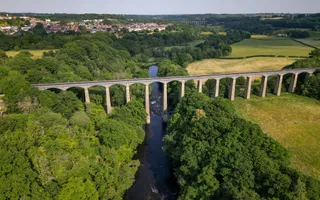The Pontcysyllte Aqueduct is a masterpiece of civil engineering, an awesome, towering structure, soaring 126 feet above the River Dee. But what does it take to preserve Wales's famous stream in the sky?
Brainchild of canal building luminaries, Thomas Telford and William Jessop, the Pontcysyllte Aqueduct was once the tallest navigable aqueduct in the world. More than just a cherished monument, this wonder of the waterways is a vital part of our network, carrying the Llangollen Canal across the River Dee in Wales and attracting thousands of visitors each year.
But restoring and maintaining this incredible ancient structure, known affectionately as “the Ponty”, poses a unique set of challenges. This year, between February and March, we carried out the first full inspection of the aqueduct in more than 20 years.
“It was a huge undertaking with lots of different challenges,” says Mark Abraham, our regional construction manager, who oversaw the inspection, “but at the same time, it was hugely rewarding. It’s not every day you work on a UNESCO World Heritage Site that’s got the same status as the Taj Mahal.”
Before work could begin, the aqueduct had to be drained. In the past, engineers would’ve simply pulled the plug (yes, there’s actually a plug), emptying the giant cast iron trough into the River Dee, below. However, in light of modern safety standards and to avoid any risk of cross-contamination, Mark and the team decided to pump the water back into the canal. As the Llangollen Canal supplies some 70,000 homes with drinking water, they also had to ensure this was safely diverted and pumped around the aqueduct while the work took place.
Once the trough was empty and all the necessary safeguards were in place, the team got to work, painstakingly going over every inch of the aqueduct. “There are 11,000 bolts on the Pontcysyllte,” Mark tells us, “and our engineers inspected 4,000 of them individually. They also checked the uprights, the metal stays, and of course, the towpath itself.”
Of the 90 metal stays – the cast iron struts that support the uprights, which in turn hold up the towpath – 21 were found to be in need of repair. While there was never any threat to the integrity of the structure, as the problem stays were spaced widely apart, these critical components have to be repaired or replaced. “The Ponty is an ancient scheduled monument,” says Mark, “so the whole point is to try and restore it using the same or similar materials.”
That’s easier said than done. Next year, the Ponty celebrates its 220th anniversary, and many of the materials used in the original build are obsolete or outdated. Wrought iron is particularly scarce, which is a big problem since it makes up the bulk of the structure, right down to the bolts that knit the aqueduct together.
To get around this, Mark employs a specialist company that sources anchor chains from old shipyards, re-stretching the wrought iron before delivering it to Mark’s team of heritage blacksmiths. It's a delicate balancing act, as Mark explains: “As these materials become harder and harder to find, the cost is going to go up, and in five years, we may not be able to lay our hands on them at all, so it’s better to order as much as we possibly can now so that future generations can carry on the restoration.”
Despite a few setbacks, Mark and the team completed the inspection ahead of schedule, reopening to boat and foot traffic in late March. “It’s been quite a challenge,” says Mark, “I started off blonde and now I’m grey! But it went really really well and it was incredibly satisfying, especially when we finally finished, put the water back in and all breathed a sigh of relief.”
But Mark’s work is far from over. The Pontcysyllte Aqueduct requires ongoing care and maintenance. Over the next few years, the team will be revisiting some of the ageing components to provide a more permanent fix, and wheels are already in motion for a major repainting project by the end of the decade.
With your help and support, we can keep the Pontcysyllte Aqueduct safe and accessible for years to come and preserve this magnificent ancient structure for future generations.







